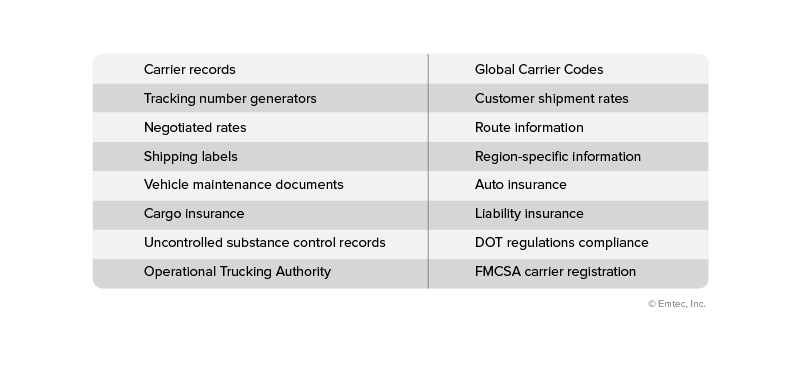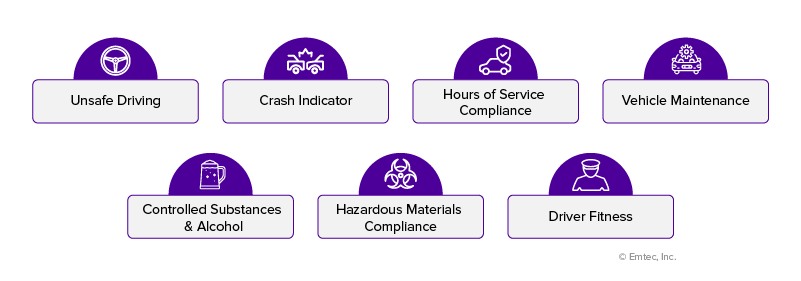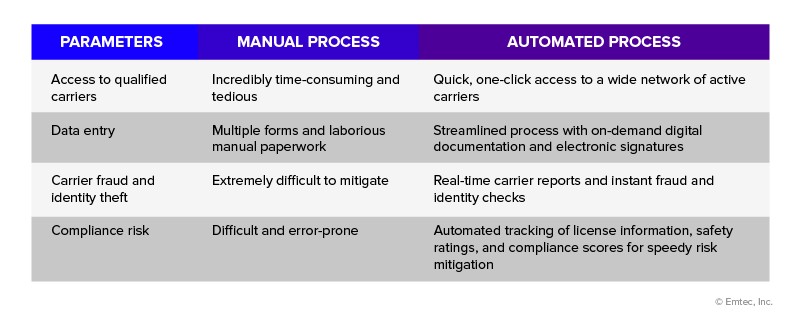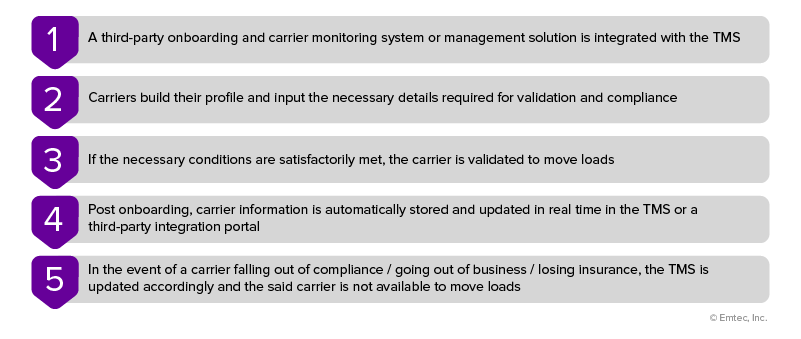07.30.21 By Sreenivas Vemulapalli

Technology is the driving force behind process optimization and efficiency in the logistics industry. Organizations are leveraging the benefits of advanced digital technologies to streamline routine operations and boost both productivity and efficiency. Robotic Process Automation (RPA) is the new industry favorite for third-party logistics (3PL) companies and freight brokers looking to optimize two of their most critical functions – carrier onboarding and compliance.
Carrier onboarding is the process of adding a new carrier and their associated transportation services to your logistics center. As the industry grows and freight movement expands globally (road transportation accounts for 70% of worldwide shipments1), it is important to partner with carriers that cover specific geographic regions. For example, if a shipper has deliveries for the west coast, they need to partner with a carrier that operates in that area, thereby streamlining shipment delivery and boosting supply chain efficiency.
However, carrier onboarding is not a simple task, with lengthy screening and compliance procedures that are time-consuming and labor-intensive. As your list of carriers expands, the more fine-tuned your organizational structure and data collection must be. In this blog, we discuss the different elements of the carrier onboarding process, and how automation streamlines these tasks for 3PL companies, guaranteeing efficiency and scalability.
As the demands placed on the logistics industry evolve, selecting the best carrier service from the wide variety of available options has become increasingly difficult. Carrier services are subject to strict compliance upheld by the Federal Motor Carrier Safety Administration (FMCSA), designed to mitigate risk, cargo theft, insurance issues, lost cargo, and other events. This protects the industry and all stakeholders, but for logistics companies, it can add extensive costs and additional paperwork. To ensure onboarding the ideal carrier that meets the necessary regulatory requirements and lowers your risk as a freight broker, adhering to detailed screening processes and compliance checklists is critical, even though this is a time-consuming and expensive task. Common carrier screening criteria include:

Carrier compliance is extremely important as it maintains an industry standard for freight delivery and regulates risk across the supply chain. In 2020, close to 900 cargo thefts occurred with an average value of over $166,000.2 Insurance claims increased by 22% in 2020, leading to a spike in bankruptcies as well.3 How a carrier manages risk has a massive impact on your business and overall financial exposure.
The FMCSA’s Compliance, Safety, and Accountability (CSA) scores are designed to limit carrier fraud, detect false insurance claims, and check carrier services that present a danger on the road. These industry compliance standards, across seven categories, focus on maintaining best practices for record-keeping, freight qualifications, safety assessments, and insurance filing — for the benefit of all stakeholders.

The better your screening and compliance process, the more secure you are in ensuring rapid and error-free movement of freight. Collecting performance data on the quality and authority of any potential carrier protects your customers and your reputation, building better trust. Carrier compliance directly benefits your business in multiple ways:
Carrier onboarding can be done either manually or through automation technology. Most logistics service providers have moved to custom web applications or logistics management systems for faster onboarding. Paperless, digital mechanisms offer several distinct advantages over paper-based, manual processes that are time-consuming and error-prone.

Typically, carrier onboarding comprises the following steps:

While digital innovation has done much to help logistics companies streamline carrier onboarding, there still are several challenges to the compliance process:
Robotic processes and multi-modal networks enable carriers and freight brokers to share data in real time, helping produce actionable insights around the carrier onboarding and compliance process. Verified Carrier Aggregator Platforms can take on the extensive task of carrier onboarding – improving business efficiency and offering analytical insights to maximize growth. Visibility of this kind, matched with data cleanup and computing power, will streamline critical business functions, allowing you to make more confident business decisions for an organized supply chain.
Robotic Process Automation (RPA) benefits carrier onboarding and compliance in three ways:
By replicating input fields in a database or locating mistakes associated with human error, robotic processes automate, collect, and store clean data. Bots can verify carrier compliance according to custom sets and delist services that fall below the required standards. Automated compliance documentation allows systems to pull data in real time, resulting in seamless communication between brokers and other parties, better organization of data, and reduction in errors – all with less manual work and cost.
Automation allows seamless integration with CRM and ERP systems, enabling accounting information, shipment tracking details, and quotations to be shared with stakeholders. Locate documents you need without effort and perform carrier audits quickly. Acquire direct access to carrier FMCSA data and peruse reviews to mitigate risks associated with non-compliant carriers. Increase the speed at which you validate and onboard carriers without lowering quality standards.
Automation can handle multiple tasks associated with carrier onboarding, facilitating heightened scalability. By automating routine compliance tasks, the strain on support teams is reduced. Use the collected data to make informed decisions, whether the information is gleaned from drivers, customers, or even granular updates on optimal shipping routes in certain regions.
Automation technology lowers costs, reduces documentation errors, boosts efficiency, and helps form better partnerships with carriers.
While the benefits of automation are clear, implementing robotic processes or integrating with verified carrier aggregator platforms is a substantial technical task. Partnering with an experienced technology consulting firm with expertise in platform enablement can help you build advanced transportation management systems to garner tangible business benefits such as:
Bridgenext (former Emtec Digital) can help you optimize the carrier onboarding process and transform your logistics business. Our rich experience in platform re-engineering enables clients to streamline critical processes and achieve scalable business growth. As a global technology services provider, we would love to discuss how advanced technologies can modernize your carrier onboarding and compliance. Contact us today!
References
https://www.shippeo.com/blog/the-3-way-win-approach-to-onboarding-carriers-onto-transportation-visibility-platforms
https://www.ccjdigital.com/business/article/15064734/recorded-cargo-theft-incidents-average-values-increased-in-2020#:~:text=The%20total%20number%20of%20cargo,233%20in%20the%20fourth%20quarter
https://www.freightwaves.com/news/commentary-the-changing-landscape-of-cargo-claims-after-covid-19-how-to-cut-losses-for-shippers-globally
https://www.shipbob.com/blog/shipping-hazardous-materials/